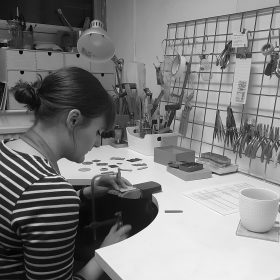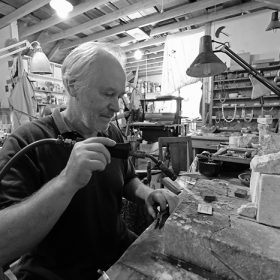Take time to discover our fabulous jewellery drawers in The Gallery where we have curated an amazing selection of jewellery by local, UK and international artists all priced under £300. The perfect place to find that special gift!
Take time to discover our fabulous jewellery drawers in The Gallery where we have curated an amazing selection of jewellery by local, UK and international artists all priced under £300. The perfect place to find that special gift!

Julie Blyfield makes jewellery, small-scale vessels and sculptural objects in her studio nestling in the garden of her home in Adelaide, South Australia. Inspired by the botanical landscape in Australia, Julie’s favoured medium of expression is silver. This she uses in its softer pure form as well as in its stronger alloyed form – sterling silver. Her jewellery and vessels are characterised by seductive textured surfaces created using traditional silversmithing techniques such as hammering, chasing, punching and piercing. Rhythmical repetition is a key element of both her design process and her aesthetic, and the use of colour is also apparent. Following the traumatising Australian bushfires of 2007, Blyfield echoed the scorched colour and searing heat with enamel paint and startling glints of gold and silver set against charred blacks and ash greys.
‘My work is inspired by the botanical landscape in Australia, which I interpret in my metal work using the technique of ‘metal raising’ and ‘chasing’. I enjoy exploring and collecting plant specimens from rich and diverse environments such as the Simpson Desert in the north of South Australia and further south around the coast of Kangaroo Island. Working with both pure silver and sterling silver as my preferred choice of material, I texture the surface to create individual pieces in the form of vessels and also more sculptural pieces. During the making process, I enjoy the way the metal ‘moves and shifts’ in almost unpredictable ways to create the organic forms which shimmer with the silver textures or colours derived from nature.’ – Julie Blyfield, 2016
Public Collections include:
Aberdeen Art Gallery; Art Gallery of Western Australia, Perth, Australia; National Gallery of Australia, Canberra, Australia; National Museums Scotland, Edinburgh; V&A, London

Shelby Fitzpatrick uses repetitive, geometric forms to create sculptural and contemporary jewellery. Her use of varying bright colours combined with laser-cut perspex, based on emerald cut shapes and facets, offers fun and playful adornment.
Originally from the USA, where she trained as a ceramicist and textile artist, she then moved to the UK to study silversmithing and jewellery at Kent Institute of Art and Design.

‘I’m passionate about the amount of energy and power that springs from the ancient craft of engraving. Works of art should be made for everyone to enjoy. Engraving is central to my design and art; it is from engraving that my other skills have evolved.’ Malcolm Appleby
Malcolm Appleby was born in 1946. He studied at Central School of Art, Sir John Cass and the Royal College of Art in London before establishing his studio in Scotland in 1969. A silversmith and metal engraver, known for his imaginative use of line and form, he considers gold ‘just another lovely material to work with.’
The Scottish Gallery has been associated with Malcolm Appleby since the 1970s; the many facets of his work have brought joy to many, each piece sold marking the beginning of a journey of discovery around this senior artist. The Gallery honoured Malcolm Appleby’s seventieth birthday in January 2016, which marked over fifty years of a creative tour de force. Appleby has dedicated his artistic practice primarily to engraving and pushing the boundaries of metalwork; constant experimentation has made him a master of his craft and in 2014 he received an MBE for his outstanding contribution to the arts.
Public Collections include:
The Victoria & Albert Museum, London; The Goldsmiths’ Company, London; British Museum, London; Royal Armouries, Tower of London; Ashmolean Museum, Oxford; Aberdeen Art Gallery & Museums; The Fitzwilliam Museum, Cambridge; National Museums Scotland, Edinburgh; and Perth Museum & Art Gallery
Malcolm’s silversmithing collection can be viewed here.

Marianne Anderson graduated from The Glasgow School of Art in 2003 with an Honours Degree in Jewellery Design. Since then, Marianne has developed her exquisite jewellery from her studio in Glasgow. Working within a restrained palette of oxidised silver, 18ct gold, red garnets and white pearls, she creates luxurious and wearable collections that reference ornamental detailing and all things decorative. Inspired by traditional decorative forms found in architectural features like decorative ironwork, Marianne skilfully uses traditional jewellery techniques to make her collections. Luxurious stone settings, intricate pierced patterns, and detailed surface texture all add to the allure of each piece. This combination of colour and artistry results in a treasury of unique and feminine pieces that are beautiful to wear.
‘My interest is rooted in how we learn and draw from the past and return frequently to designs, motifs and patterns of historic and symbolic significance. By purposefully engaging with the past, my aim is to highlight the importance of ornament in a modern context. Far from superfluous, ornament has always had its own vocabulary and meaning and I try to engage with this through my work.’

Elizabeth Jane Campbell graduated from Edinburgh College of Art in 2013, and then spent a year as Artist in Residence at Glasgow School of Art before establishing her own studio in Edinburgh. Elizabeth’s award winning jewellery has been exhibited across the UK and abroad – most recently in Milan, Munich and America.
‘My recent work explores the connection between colour and shape – taking inspiration from colour theory, colour connotations and visual literacy. Using vitreous enamel enables me to achieve fantastic colours which I contrast with simple oxidised silver settings. The surface finish of the enamel is really important, as a gloss or matt finish can really change the quality of the enamel colour. Each piece is hand finished to highlight the vibrancy of the colour.’
Permanent collections include:
The National Museum of Scotland, Edinburgh; The Goldsmiths’ Company, London
Elizabeth was the subject of a solo exhibition in March 2020 – Colour Connections. Read our blog for an insight into her studio and the inspiration behind her work.

The unique landscape of the Orkney Islands provides inspiration for Grace Girvan’s work. She enjoys beach combing and uses the objects that she unearths on her expeditions in her work, combining found objects such as pebbles, driftwood and shell with precious metal and enamel. Her work is evocative of her inspiration, through a restrained colour palette of soft greys, blues, greens and browns she conveys the washed out, sun bleached colours of the sea and shore.
Public Collections include:
Aberdeen Art Gallery and Museums, Aberdeen
Born in Lisburn, Northern Ireland in 1948, Jamison first studied in Belfast before concentrating on Jewellery Design at Central St Martins in London, graduating in 1972. Nuala Jamison was a pioneer of modern jewellery, specialising in acrylic – her work is synonymous with enhancing the wearer with colour and light. Jamison was also an art educator and taught jewellery at Morley College in London as well as summer classes in Ireland. Her sculptural jewellery was inspired by urban city spaces as well as the southern Irish coastline; between London and County Cork, she felt she had the best of both worlds. During the course of her life in jewellery, Jamison designed accessories for the iconic clothing designer Jean Muir and in the 1980’s she enjoyed a collaborative partnership with Caroline Broadhead and produced a line of acrylic jewellery called C&N. In July 2016 we celebrated Nuala’s career with the solo exhibition Faceted Light. The Scottish Gallery has proudly represented Nuala’s work for over thirty years.
Jamison carved and shaped her pieces with pumice over several weeks to achieve a weathered appearance. Above all, Jamison loved colour and more recently she had developed ways of dyeing and colouring acrylic to enhance the reflective qualities – sometimes creating a subtle blend of shades and other times mixing together contrasting colours or cutting facets to reveal more light. Her work is held in numerous public collections worldwide.

Ann Little graduated from Edinburgh College of Art in 1996.
“Most of my jewellery incorporates slate or enamel. When I first set up in business I concentrated on hand cutting and filing slate, sometimes inlaying silver and mother-of-pearl. With the purchase of a kiln for enamelling, I began to introduce colour combining enamel with slate, making many pieces reversible to give the wearer a choice of colour. I use enamel powder dry, sprinkling on thin layers of colour, sometimes drawing into the powder enamel or rubbing it back once fired to reveal colours underneath. I also enamel on thin copper shim overheating the enamel to make it burn away from the raised marks that are scored into the metal. My latest work now involves simple, bold shapes.” – Ann Little
Public Collections include:
Aberdeen Art Gallery and Museum; National Museums Scotland, Edinburgh

“Working in silver is inspiring and creative, technical and expressive. Using the traditional techniques of the silversmith as my foundation, I build pieces that explore the relationship between functionality and self-expression. I want my work to be individual in design and concept and give pleasure to the user. There is something magical about silver. When it arrives in the brown paper and card board packaging, which is promptly unwrapped and examined, a voyage of discovery begins. I have never once look at a sheet of silver and thought nothing of it. My mind skips to the possibilities and the ideas that I originally purchased the metal for tend to pale in the face of the endless possibilities that lie before me. Soft and rounded, or crisp with sharp edges and plain bold surfaces! Silver, you will find, can do it all.” – Grant McCaig

Guy Royle’s jewellery inhabits a space between the definitions of Art and Craft; mingling influences from both, yet never so far as becoming exclusively one or the other. Brooches are paintings in metal, necklaces are sculptures for the human form, while the tones, shades and textures of raw materials are his palette. This combination of elements brings a timeless and natural quality to his work. What is more, Guy’s jewellery is graceful for its functionality; whatever beauty stems from his work, has derived, and is inseparable from its intent to be worn.
Using the simplest of tools and methods, he works mainly with sheet silver, which is cut, bent, beaten and formed. This metal work compliments his use of natural pebbles and semi-precious stones, which are ground, shaped and drilled into beads.
Since the nineteen-eighties Guy has made a name as a jeweller, however, his varied practice includes printing, painting and weaving. Except for his time at Morley College of Art, Guy is largely self-taught. Perhaps more valuable than any formal education, 25 years as an assistant to the artist Breon O’Casey’s has proved of deeper and more longstanding influence.

Misun Won graduated with a masters degree in 2008 from Edinburgh College of Art. Originally from Korea, her work is associated with the delicacy of highly refined handcraft from the East. Her extensive experience of living and working in both Britain and Korea has given her a broader cultural outlook. It has enabled her to position herself in what she calls “neutral territory” and to examine both cultures with “fresh eyes”. Influences from both countries can be seen in her work: a major inspiration is Korean patchwork, but this highly traditional form is interpreted through Western fractal geometry; creating dynamic structures for her collection.
Misun received a commendation at Goldsmiths’ Fair 2019 for her latest collection.